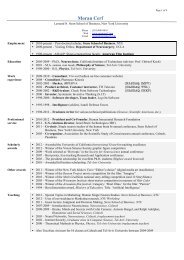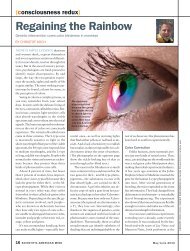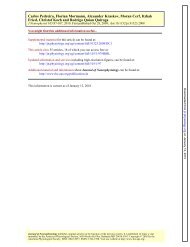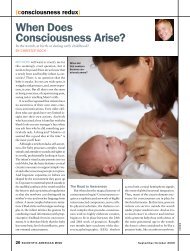Semiconductor physics
Semiconductor physics
Semiconductor physics
You also want an ePaper? Increase the reach of your titles
YUMPU automatically turns print PDFs into web optimized ePapers that Google loves.
CNS182 Caltech, Liu&Delbruck 1/10/2007<br />
MOS transistors – the dominant technology<br />
p+ p+ n+ n+<br />
np-<br />
We need to understand enough about semiconductors and<br />
junctions to understand how MOS transistors work<br />
•Insulators, conductors, semiconductors<br />
•Crystal structure of silicon<br />
•Band structure (valence, conduction, and forbidden bands)<br />
•Holes and electrons<br />
•Mechanisms of charge transport (diffusion & drift)<br />
•Doping with donors and acceptors<br />
•Fermi-Dirac distribution<br />
•Law of mass action (np=n i 2 )<br />
•p-n junction<br />
•Reverse biased junction and its capacitance<br />
The Diamond Structure of Silion<br />
Each atom is<br />
covalently<br />
bonded to 4<br />
neighbors<br />
Si dominates because it has a clean oxide interface: SiO 2<br />
Energy bands arise from periodic strcture of<br />
crystal<br />
Wavefunctions of<br />
electron in a box<br />
Energy levels<br />
A crystal is like a periodic box<br />
•Only wavefunctions with discrete<br />
nonzero energies act like free<br />
particles<br />
•Wavefunctions at forbidden<br />
energies die off exponentially<br />
E c<br />
Conductors, <strong>Semiconductor</strong>s and Insulators<br />
Energy bands<br />
Electrons and holes<br />
Mead, 1988<br />
Grove, 1969<br />
• Electrons in the conduction band act like free particles<br />
• Holes are bubbles in the valence band and also act like<br />
free particles<br />
• The electrons move, but it is easier to talk about the<br />
vacancy (the hole) moving, just like it is easier to talk<br />
about a bubble moving than about the water around it<br />
moving<br />
• Quantum-mechanically, a hole acts like an electron,<br />
except that holes have positive charge and the<br />
effective mass in silicon is 2.5 times larger for a hole<br />
than for an electron<br />
Lecture 2, <strong>Semiconductor</strong> <strong>physics</strong> 1
CNS182 Caltech, Liu&Delbruck 1/10/2007<br />
Energy<br />
relative<br />
to Fermi<br />
level in<br />
kT units<br />
The meaning of energy in the band<br />
diagram<br />
E g=1.2eV=50kT<br />
The Fermi-Dirac distribution of exclusionary<br />
state occupation at thermal equilibrium<br />
States above Fermi level are occupied with Boltzman distribution<br />
−( E−Ef)/ kT<br />
p(occupied) ≈ e<br />
States at the Fermi level are ½ occupied<br />
States below Fermi<br />
level are unoccupied<br />
with Boltzman<br />
distribution<br />
−( E f −E)/<br />
kT<br />
p(unoccupied) ≈ e<br />
Probability of occupation of a state<br />
The thermal energy<br />
• Each degree of freedom of a system in<br />
thermal equilibrium has average energy kT/2<br />
• The thermal voltage kT/q is the voltage a<br />
single charge falls through to pick up the<br />
thermal energy kT<br />
• kT/q=25mV=1/40V at room temperature<br />
• kT/q is the natural scale of voltage for<br />
electronic systems in thermal equilibrium<br />
• The band gap of silicon (1.2eV) is about 50<br />
times kT<br />
An intrinsic semiconductor (no dopants)<br />
Band<br />
diagram<br />
Density<br />
of states<br />
Fermi-Dirac<br />
distribution<br />
Carrier<br />
concentrations<br />
Donors and Acceptors in the periodic table A donor atom donates a free electron<br />
Binding energy of electron is<br />
reduced from free atom<br />
binding energy (~0.5 eV) by<br />
silicon dielectric constant<br />
ε Si ≈12ε 0<br />
0.<br />
5eV<br />
Ebinding ≈ ≈ 0.<br />
05eV<br />
≈ 2kT<br />
12<br />
At 300K, nearly all donor<br />
electrons are free – because<br />
there are many more ways to<br />
be free than bound<br />
Lecture 2, <strong>Semiconductor</strong> <strong>physics</strong> 2
CNS182 Caltech, Liu&Delbruck 1/10/2007<br />
Doping levels<br />
• Concentration of Si is about 10 23 /cm 3<br />
• Doping can vary from about 10 15 /cm 3 to<br />
10 19 /cm 3<br />
• These doping levels still represent only<br />
a tiny fraction of the total atoms, from<br />
10 -8 to 10 -4<br />
The law of mass action: np=n i 2<br />
• In equilibrium, more holes means less<br />
electrons, and vice-versa.<br />
• np=n i 2<br />
• n i is the intrinsic carrier density<br />
• n i increases with temperature<br />
• At room temperature n i is 10 10 /cm 3 , or<br />
about 1/10 13 Si atoms.<br />
Mobility is a function of electric field<br />
Grove 1969<br />
An n-type semiconductor<br />
A p-type semiconductor<br />
An electric field causes carriers to drift<br />
<br />
J = μ(<br />
Eqn )<br />
Lecture 2, <strong>Semiconductor</strong> <strong>physics</strong> 3<br />
Current<br />
Flux<br />
Charge density<br />
Electric field<br />
Mobility<br />
<br />
J ≈ μqnE<br />
<br />
for E that causes velocities<br />
much less than the thermal velocity<br />
A density gradient causes carriers to<br />
diffuse<br />
Diffusion current<br />
<br />
J = −Dq∇n Current<br />
Flux<br />
Diffusion<br />
constant<br />
Charge<br />
density
CNS182 Caltech, Liu&Delbruck 1/10/2007<br />
Drift and diffusion are related by<br />
The Einstein relation<br />
<br />
J =−Dq∇n J ≈ μqnE<br />
diffusion<br />
kT<br />
D = μ<br />
q<br />
drift<br />
This relation got Einstein his Nobel prize<br />
A P-N junction<br />
N-type P-type<br />
Electric field<br />
Diffusion of holes from p region<br />
Diffusion of electrons from n region<br />
In equilibrium, Drift = Diffusion for electrons and holes<br />
Electrostatic<br />
Potential: potential<br />
energy of positive<br />
charge<br />
Potential energy of<br />
negatively charged<br />
electron<br />
Electrostatic potentials in a PN<br />
junction<br />
N-type P-type<br />
φ<br />
φ e<br />
E<br />
A P-N junction<br />
Mobile majority carriers<br />
N-type P-type<br />
Fixed ions<br />
“Depletion region”<br />
“Space-charge region”<br />
Charges, fields, and potentials in a PN<br />
junction<br />
N-type P-type<br />
Lecture 2, <strong>Semiconductor</strong> <strong>physics</strong> 4<br />
Charge<br />
density<br />
Electric<br />
field<br />
N D<br />
Electrostatic<br />
potential<br />
Q<br />
φ<br />
E<br />
N A<br />
kT N N<br />
ϕ T = log( )<br />
q n<br />
A D<br />
2<br />
i<br />
Typically, the built-in voltage, ϕ T , is about 0.75V<br />
Carrier densities in a PN junction<br />
log scale<br />
n<br />
n i<br />
N-type P-type<br />
depletion region—both n and p are far below doping values<br />
p<br />
np=n i 2
CNS182 Caltech, Liu&Delbruck 1/10/2007<br />
Carrier densities in a PN junction<br />
N-type P-type<br />
linear scale<br />
n<br />
ni depletion region—both n and p are far below doping values<br />
p<br />
np=n i 2<br />
MOS transistors – the dominant<br />
technology<br />
p+ p+ n+ n+<br />
n<br />
Next week:<br />
Understanding how MOS transistors work in weak<br />
and strong inversion<br />
p<br />
What was covered<br />
– Insulators, conductors, semiconductors<br />
– Crystal structure of silicon<br />
– Band structure (valence, conduction, and<br />
forbidden bands)<br />
– Holes and electrons<br />
– Mechanisms of charge transport (diffusion &<br />
drift)<br />
– Doping with donors and acceptors<br />
– Fermi-Dirac distribution<br />
– Law of mass action (np=n i 2 )<br />
– p-n junction<br />
Lecture 2, <strong>Semiconductor</strong> <strong>physics</strong> 5






